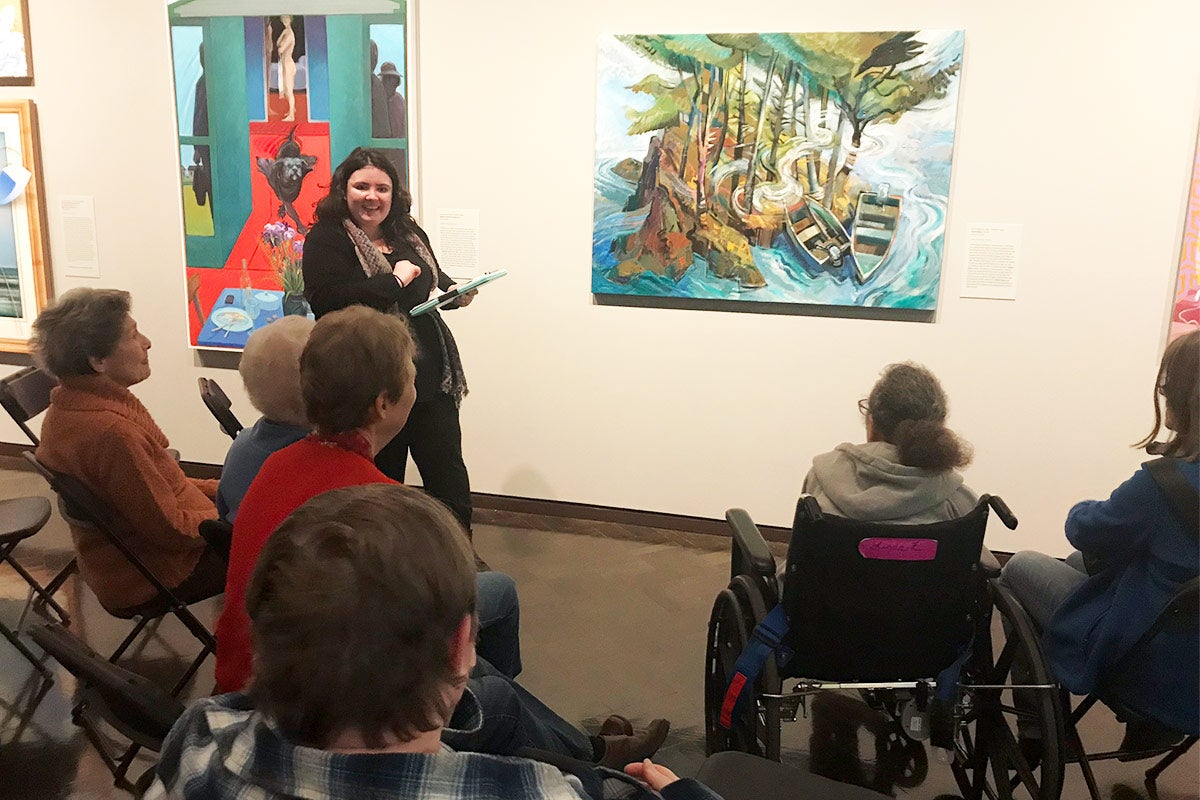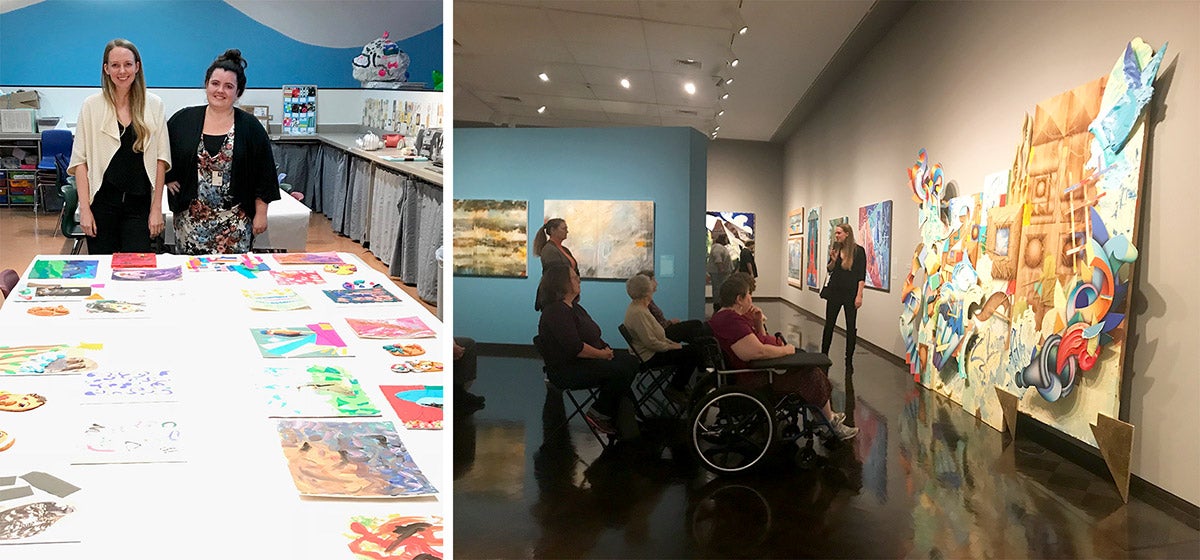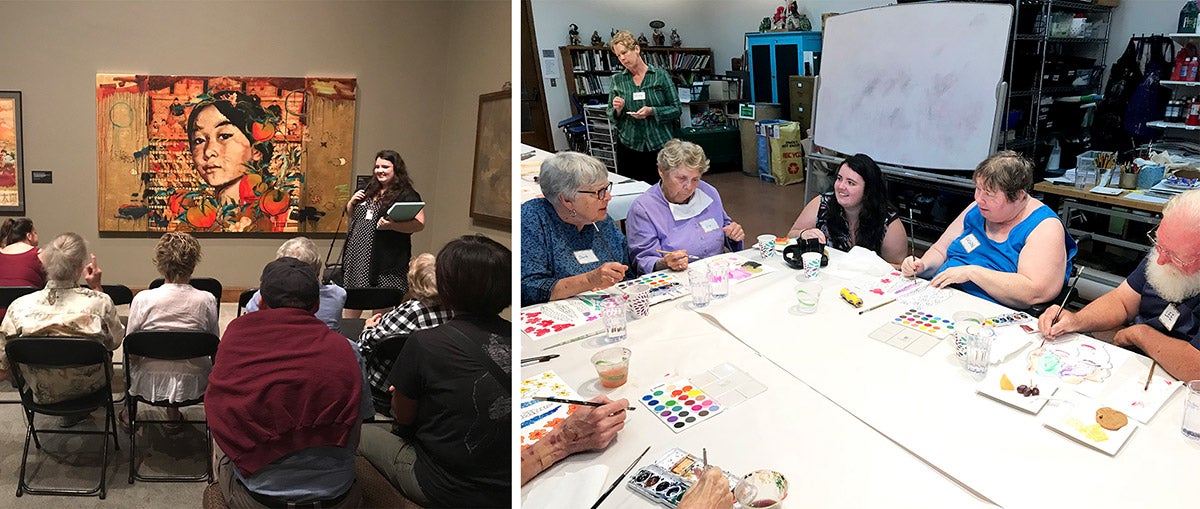 PPPM graduate student Rosemarie Oakman leads Reflections & Connections at the Jordan Schnitzer Museum of Art
PPPM graduate student Rosemarie Oakman leads Reflections & Connections at the Jordan Schnitzer Museum of Art
Susan Bliven had zero background in art when she signed up for a gallery discussion and artmaking program at the Jordan Schnitzer Museum of Art.
“I thought there was no way I could make art. I was known for my stick figures,” Bliven said. “But now, very few days go by without painting. It’s become a part of who I am, and I never would have expected it.”
“I’ve seen Susan bloom from this,” her husband Lee added. “It’s amazing how vibrant her paintings are becoming. She’s a fabulous artist.”
Bliven (Biology BS ’86) has vascular dementia, and she is a participant in the Reflections & Connections program at the JSMA (in partnership with the Oregon and Southwest Washington chapter of the Alzheimer’s Association), that provides access for individuals with early-onset and early to mid-stage dementia and their care partners. The free program series features six weekly two-hour workshops where participants engage in conversation-based gallery tours and artmaking sessions.
Reflections & Connections was created by Rosemarie Oakman, a current graduate student pursuing a Masters of Nonprofit Management as well as the Graduate Certificate in Arts Management in the School of Planning, Public Policy and Management (PPPM), and Hannah Bastian, a 2017 College of Design graduate with an MS in Arts Management and a Graduate Certificate in Nonprofit Management. Bastian is now the Museum Educator for Studio Programs and Special Projects, while Oakman is the Arts in Healthcare Coordinator graduate employee at the museum and in PPPM.
 Alumna Hannah Bastian and Oakman in the JSMA studio (left); Bastian leads a Reflections & Connections session
Alumna Hannah Bastian and Oakman in the JSMA studio (left); Bastian leads a Reflections & Connections session
Launched in August of 2018, the program is now in its fourth session and will continue indefinitely. Opening May 13 is an exhibition of the artwork made by participants in the JSMA’s lower hall.
“This program is incredibly important because right now more than 5 million Americans have Alzheimer’s disease,” Oakman said. “Those numbers will continue to grow until a cure is found.”
The program is modeled after Meet Me at the MoMA, a project created to provide art access for people with dementia at New York’s Museum of Modern Art. Oakman and Bastian also observed similar programs at the Frye Art Museum in Seattle and the Portland Art Museum. Oakman and Bastian completed a series of trainings with the Alzheimer’s Association that qualify them to lead workshops.
Before attending the College of Design, both Oakman and Bastian had worked with art and people who had dementia.
“I was seeing the way that art in that community was bringing people together,” Bastian said. “And being able to display your work and being able to create and be together in a community was so powerful and fun. I knew I wanted to find a way to combine the two more fully in my life, to combine working with people with Alzheimer’s and art creation. That’s actually what led me to come here to this university.”
“I’d been working with people with dementia for seven years,” added Oakman, who also spearheaded the Alzheimer’s Glass & Iron project. “The arts are an amazing way not only to communicate with someone with dementia and allow them to express themselves, but it’s just such an amazing connector for community.”
Oakman is currently the research assistant for a book project on creative aging by PPPM professors Patricia Lambert and Doug Blandy.
For each workshop, Oakman picks out three pieces of artwork at the museum with a common theme, and then Oakman and Bastian lead discussions using Visual Thinking Strategies, a method developed by Philip Yenawine that uses art to deepen critical thinking and communication skills. Each series is capped at five pairs—a person diagnosed with dementia and their care partner, who is sometimes a family member, sometimes not. During gallery conversations, participants sit in chairs within feet of the artwork they’re discussing, be that a Pablo Picasso or a Joan Mitchell. The newly acquired Hung Liu large-format multimedia piece, “All My Ancestors,” has been particularly engaging.
“It really speaks to the idea of heritage, which I think is something a lot of older Americans think about: What lineage am I leaving behind? Or, where do I come from?” said Oakman.
She noted that these discussions spur interactions that wouldn’t happen otherwise, like a daughter hearing her mother tell a story for the first time because a specific artwork sparked something in her.
After the gallery discussion, the group heads to the museum’s art studio, where Oakman leads art activities, from modeling clay faces inspired by Picasso or painting abstract watercolors.
 Hung Liu's 'All My Ancestors' multimedia artwork (left); Susan and Lee Blevin (pictured right) paint after a gallery discussion
Hung Liu's 'All My Ancestors' multimedia artwork (left); Susan and Lee Blevin (pictured right) paint after a gallery discussion
“It’s so powerful. People remember how good they feel making art,” Bliven said. “It’s a sense of accomplishment that we often don’t get. People who have dementia, we are often marginalized and so having a program where we are not just accepted but actually celebrated and supported is incredibly powerful and meaningful.” Bliven’s watercolors will also be on display at the Gallery at the Eugene Airport April 23 through July 22 in an exhibit titled Art Heals at the Jordan Schnitzer Museum of Art.
Oakman says her time with Susan and other participants has changed her view of the world.
“It made me realize this is going to be my life work,” Oakman said.
To find out more or to register for future workshops contact The Alzheimer’s Association Oregon & Southwest Washington Chapter at 1-800-272-3900.
